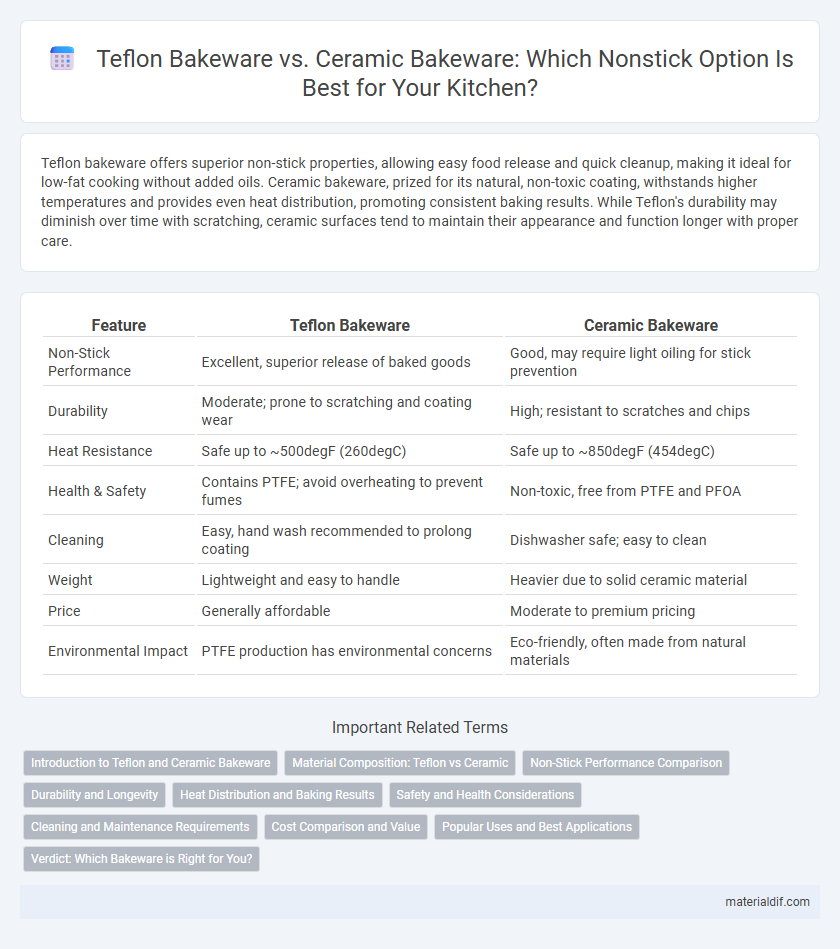Teflon bakeware offers superior non-stick properties, allowing easy food release and quick cleanup, making it ideal for low-fat cooking without added oils. Ceramic bakeware, prized for its natural, non-toxic coating, withstands higher temperatures and provides even heat distribution, promoting consistent baking results. While Teflon's durability may diminish over time with scratching, ceramic surfaces tend to maintain their appearance and function longer with proper care.
Table of Comparison
| Feature | Teflon Bakeware | Ceramic Bakeware |
|---|---|---|
| Non-Stick Performance | Excellent, superior release of baked goods | Good, may require light oiling for stick prevention |
| Durability | Moderate; prone to scratching and coating wear | High; resistant to scratches and chips |
| Heat Resistance | Safe up to ~500degF (260degC) | Safe up to ~850degF (454degC) |
| Health & Safety | Contains PTFE; avoid overheating to prevent fumes | Non-toxic, free from PTFE and PFOA |
| Cleaning | Easy, hand wash recommended to prolong coating | Dishwasher safe; easy to clean |
| Weight | Lightweight and easy to handle | Heavier due to solid ceramic material |
| Price | Generally affordable | Moderate to premium pricing |
| Environmental Impact | PTFE production has environmental concerns | Eco-friendly, often made from natural materials |
Introduction to Teflon and Ceramic Bakeware
Teflon bakeware features a non-stick coating made from polytetrafluoroethylene (PTFE), providing easy release of baked goods and effortless cleanup. Ceramic bakeware, crafted from natural clay and coated with a non-reactive glaze, offers excellent heat retention and an eco-friendly alternative to traditional non-stick pans. Both materials cater to different baking preferences, with Teflon prioritizing convenience and ceramic emphasizing durability and chemical-free cooking.
Material Composition: Teflon vs Ceramic
Teflon bakeware features a non-stick coating made from polytetrafluoroethylene (PTFE), providing a smooth surface that resists food adhesion and requires less oil for cooking. Ceramic bakeware is composed of inorganic materials such as clay and silica, coated with a non-reactive, durable glaze that offers a naturally non-stick surface without synthetic chemicals. The key distinction lies in Teflon's synthetic polymer base with excellent non-stick properties and ceramic's mineral-based structure favored for chemical-free baking and enhanced heat resistance.
Non-Stick Performance Comparison
Teflon bakeware delivers superior non-stick performance due to its polytetrafluoroethylene (PTFE) coating, which provides excellent food release and requires minimal oil or butter, enhancing healthier cooking. Ceramic bakeware offers a natural non-stick surface but tends to lose its effectiveness over time due to wear and chipping, resulting in increased sticking. The durability and consistent non-stick quality of Teflon make it a preferred choice for users seeking effortless cleanup and reliable food release in baking applications.
Durability and Longevity
Teflon bakeware offers excellent non-stick properties but tends to degrade over time due to its polymer coating wearing off, especially at high temperatures or with frequent use. Ceramic bakeware, made from inorganic materials, provides superior durability and retains its non-stick surface longer without releasing harmful chemicals. When evaluating longevity, ceramic bakeware generally outlasts Teflon by maintaining structural integrity and consistent performance through extensive use.
Heat Distribution and Baking Results
Teflon bakeware offers superior non-stick properties and heats up quickly but often results in uneven heat distribution, leading to inconsistent baking outcomes. Ceramic bakeware provides more uniform heat distribution, which helps achieve evenly baked goods with a consistent texture and color. While Teflon's rapid heating suits quick recipes, ceramic bakeware excels in baking precision and durability.
Safety and Health Considerations
Teflon bakeware contains polytetrafluoroethylene (PTFE), which can release toxic fumes if overheated above 500degF (260degC), posing respiratory risks and potential polymer fume fever. Ceramic bakeware is free from PTFE and PFOA, offering a non-toxic, chemical-free alternative that remains stable at high temperatures without releasing harmful substances. Choosing ceramic bakeware reduces exposure to hazardous compounds and is considered safer for long-term health and eco-friendly cooking practices.
Cleaning and Maintenance Requirements
Teflon bakeware features a non-stick coating that simplifies cleaning by preventing food from adhering, allowing for quick rinsing with mild soap and warm water. Ceramic bakeware requires gentle hand washing to avoid chipping and may need soaking to remove baked-on residues, demanding more careful maintenance. Both types avoid abrasive cleaning tools, but Teflon's resilience enhances durability with less frequent maintenance compared to ceramic surfaces.
Cost Comparison and Value
Teflon bakeware typically costs less upfront than ceramic bakeware, making it a budget-friendly choice for everyday cooking. While ceramic bakeware tends to be more expensive, it offers superior durability and a non-toxic surface that resists scratches and stains. Evaluating long-term value, ceramic's longer lifespan and eco-friendly qualities may offset its higher initial price compared to Teflon's affordability and convenience.
Popular Uses and Best Applications
Teflon bakeware excels in non-stick cooking applications such as baking delicate items like cookies and muffins, where easy release and minimal oil usage are essential. Ceramic bakeware is preferred for recipes requiring even heat distribution and high-temperature durability, making it ideal for casseroles and lasagnas. Both materials offer versatility, but Teflon's non-stick surface suits low to medium heat baking, while ceramic handles higher heat and retains moisture for slow-cooked dishes.
Verdict: Which Bakeware is Right for You?
Teflon bakeware offers superior non-stick performance and easy cleanup, ideal for low-fat cooking and delicate baked goods, while ceramic bakeware provides excellent heat distribution and is free from PTFE and PFOA chemicals, making it a safer choice for health-conscious users. Durability varies, with Teflon coatings prone to scratching over time, whereas ceramic surfaces maintain integrity but may chip if mishandled. Choosing between Teflon and ceramic bakeware depends on prioritizing non-stick convenience versus chemical safety and long-term durability.
Teflon bakeware vs Ceramic bakeware Infographic

 materialdif.com
materialdif.com